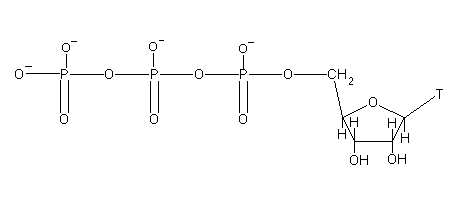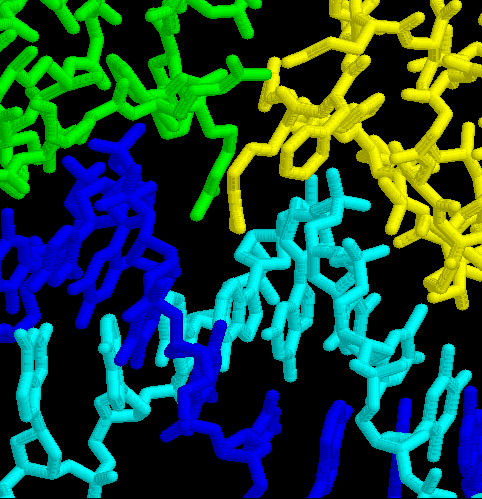
There is no time limit on this test, though I have tried to design
one that you should be able to complete within 3 hours, except
for typing. You are not allowed to use your notes, or any books,
any electronic notes or old tests, nor are you allowed to discuss
the test with anyone until Wednesday Feb. 9, 2000. EXAMS ARE
DUE AT 11:30 ON WEDNESDAY, FEBRUARY 9. You may use a calculator
and/or ruler and you must use the internet for one question but
you are NOT allowed to use any of the computers in the molecular
lab for this question. The answers to the questions must be typed
on a separate sheet of paper unless the question specifically
says to write the answer in the space provided. If you do not
write your answers on the appropriate pages, I may not find them
unless you have indicated where the answers are.
-3 pts if you do not follow this direction.
Please do not write or type your name on any page other than this
cover page. Staple all your pages (INCLUDING THE TEST PAGES)
together when finished with the exam.
Name (please print here):
Write out the full pledge and sign:
Here is the honor code
http://www.davidson.edu/student/redbook/honorgeneral.html#honorcode
"On my honor I have neither given nor received unauthorized information regarding this work, I have followed and will continue to observe all regulations regarding it, and I am unaware of any violation of the Honor Code by others."
How long did this exam take you to complete (excluding typing)?
Average was 84% with range of 99% - 55%
14 pts.
1. Starting with this peptide (MENAHTKTVEEVLGHFGVNESTGLSLEQ),
answer the following questions. Use the web
page from lab and the internet to answer these questions:
a. From what protein and species is this peptide derived (see search results)
Rat Calcium ATPase
b. Find the cDNA online and design two PCR primers to clone the
ORF. Write down the sequences of your primers.
forward primer
5' atggag aacgctcaca caaa 3'
reverse primer 5' tcaaga ccagaacata tcac 3'
c. Print the page with your DNA sequence
d. From what tissue was this cDNA produced?
brain
10 pts.
2. In the space provided, draw a TTP. You may write just the
letter "T" for the base.

10 pts.
3. List the steps you would need to perform if you wanted
to do a Southern blot of your lab partner to see if she or he
were diploid or haploid. Do not worry about details (e.g. specifically
which enzyme you might use) but make sure you tell me the common
steps in all Southern blots. Also, describe the probe you would
use. You will not know the exact probe, but tell me the general
properties you would want in said probe.
Isolate DNA (with permission)
digest DNA with restriction enzyme
electrophorese DNA
denature DNA with NaOH
blot and block DNA on membrane (e.g. nitrocellulose)
hybe with probe
wash
detect probe
Probe would need to bind
to polymorphic locus so that most people were heterozygous. If
my partner came up with one band, I would want to try another
locus or two to deterime if he/she were haploid or homozygous.
8 pts.
4. Explain how the pET expression system works. You MUST draw
a picture of the pET plasmid and label all its parts to receive
full credit.
There are two parts to the
pET expression system. First, the plasmid contains YF-DNA cloned
downstream of a T7 promoter site. This plasmid also contains amp
resistance and origin of replication.
The host cell has a modified genome such that the T7 RNA pol gene
is inserted into its chromosome and can be activated with the
addition of IPTG. When IPTG is added, T7 RNA pol is made, binds
to the promoter upstream of YFDNA and transcribes it. The cell
then translates it and you have tons of YFP.
8 pts.
5. Design an experiment to determine the molecular weight
of the only human Mg channel that is found in the basement membrane
of toenails. You must determine the molecular weight by an experiment
with real protein; you cannot use only electronic information.
All you know at this point is that mice have the same protein
and that mouse cDNA has been cloned and sequenced.
First, you need to isolate the human cDNA. Use the mouse cDNA as a probe and screen a human toenail cDNA library. Then, either express this in pET system and determine the MW of the human version with SDS-PAGE, or use this to produce a mAb against the human protein and use it on a western blot of toenail protein.
4 pts.
6. Describe how blue/white selection works when cloning DNA.
Blue/white selection works
when an insert is cloned into a polylinked located within the
lacZ coding sequence. If an insert is cloned, the coding sequence
is disrupted and no b-galactosidase will be produced. If
there is no insert, the b-galactosidase
is made. b-galactosidase turns the colorless
substrate X-gal from clear to blue. So no insert = blue colonies.
Insert = white colonies.
12 pts.
7. Read this sequencing gel. Write down the template
sequence from
which this radioactive DNA was derived. Make sure you write your
answer from 5' to 3'.

5' GCA TAC GCA
AGT CCC AAA ATG CCG CGT ATA GCA TCC GAC TAA CTG ACT TAC GGA ACT
CGA 3'
12 pts.
8. Go to this URL: <bio.davidson.edu/Biology/Courses/Molbio/Exams/2000/exam1fig1.gif>

You will see a picture of two DNA-binding proteins binding to
DNA (DNA is the two shades of blue). Find the two amino acids
binding in the minor groove. Now go to this URL <bio.davidson.edu/Biology/aatable.html>.
a. Explain to me why it makes sense that these amino acids are
both R.
Since R has a positive charge,
it will interact with the negative charges on the phosphate backbone.
b. Pick a conservative substitution that you think would not disrupt
the quaternary structure depicted. Explain your answer.
Two good answers - K most popular.
c. Choose the most disruptive amino acid substitution you can
imagine and explain your choice.
Many good choices. Y, W, G,
E, D most common answers.
12 pts.
9. The following requests have been picked up from Mars. It
appears that a life form on Mars has taken the Mars landers hostage
until the following answers can be obtained. (You see, Martians
cannot take molecular biology and they are mean, green, and angry!)
a. Make 350 mL of a solution that is 70 mM KCl, 10% w/v sarkosyl,
and 0.15 M
Tris-HCl (pH 7.8). (FW KCl = 74.5; FW Tris = 121; FW sarkosyl
= 293)
Start with about 200 ml of
water
1.83 g KCl
35 g sarkosyl
6.35 g Tris
pH to 7.8 with HCl
add water to 350 ml
b. Make 125 mL of a 0.45% agarose gel in 0.5X TBE when you
are given 10X TBE stock solution. (FW agarose 66; FW TBE = 123)
6.25 ml stock TBE
water up to 125 mL
add 0.56 g agarose, microwave, pour.
c. What is the concentration of a stock solution of DNA when
the OD260 of some DNA reads 0.025 and this DNA was made by diluting
3 µL of the stock solution into a final volume of 400µL?
FREEBIE SINCE I FORGOT TO GIVE
YOU CONVERSION FORMULA.
d. Tell me how to make 600 mL of a solution that is 0.015M
NaCl, 5% v/v SSC, and
250 mM NaOH. (FW NaCl = 58.44; FW NaOH = 40; you have a stock
solution of SSC).
Start with 500 mL of water:
add 0.526 g NaCl
30 mL SSC stock
6 g NaOH
add water to 600 mL
10 pts.
10. Figure out how to subclone the shaded piece of DNA into
a new copy of the same plasmid. Remember to include an experiment
to verify that you have cloned the correct piece. In the diagram,
K, S, R, X, P, N all represent different restriction sites. The
sizes of the fragments are given in kb. Notice that this big fragment
has been cloned into a polylinker where the different restriction
sites are very close to one another.
Subclone:
Digest with S and K.
gel purify 3.0 kb fragment
digest pProblem2000 with S
Ligate insert into pRoblem2000
Verify:
Since there is no lacZ gene in the original plasmid, blue/white
selection cannot be used.
So, you have to do minipreps and digest with P to verify 6.0 kb
piece of DNA
and also K and S double digestion to verify 3.0 kb (mixture of
plasmid and correct insert)